Thermal Expansion and Polymorphism of Slawsonite SrAl2Si2O8
Abstract
1. Introduction
2. Materials and Methods
3. Results and Discussion
3.1. Polymorphism of Natural SrAl2Si2O8 in a Temperature Range 27–1000 °C
3.2. Slawsonite Thermal Expansion
4. Conclusions
Supplementary Materials
Author Contributions
Funding
Data Availability Statement
Acknowledgments
Conflicts of Interest
References
- Chen, S.; Zhu, D.-G.; Cai, X.-S. Low-temperature densification sintering and properties of monoclinic-SrAl2Si2O8 ceramics. Metall. Mater. Trans. A 2014, 45, 3995–4001. [Google Scholar] [CrossRef]
- Chen, S.; Zhu, D.-G. Low-temperature sintering behavior and properties of monoclinic-SrAl2Si2O8 ceramics prepared via an aqueous suspension milling process. J. Mater. Sci. Mater. Electron. 2016, 27, 11127–11136. [Google Scholar] [CrossRef]
- Zhao, S.; Qin, S.; Jia, Z.; Fu, S.; He, P.; Duan, X.; Yang, Z.; Li, D.; Jia, D.; Zhang, J.; et al. From bulk to porous structures: Tailoring monoclinic SrAl2Si2O8 ceramic by geopolymer precursor technique. J. Am. Ceram. Soc. 2020, 130, 4957–4968. [Google Scholar] [CrossRef]
- Li, L.; Liu, X. Effects of changing the M2+ cation on the crystal structure and optical properties of divalent samarium-doped MAl2Si2O8 (M = Ca, Sr, Ba). RSC Adv. 2015, 5, 19734. [Google Scholar] [CrossRef]
- Li, X.; Yang, C.; Liu, Q.; Wang, X.; Mi, X. Enhancement of luminescence properties of SrAl2Si2O8: Eu3+ red phosphor. Ceram. Int. 2020, 46, 17376–17382. [Google Scholar] [CrossRef]
- Dai, W.; Hu, J.; Liu, G.; Xu, S.; Huang, K.; Zhou, J.; Xu, M. Thermometer of stable SrAl2Si2O8: Ce3+, Tb3+ based on synergistic luminescence. J. Lumin. 2020, 217, 116807. [Google Scholar] [CrossRef]
- Wang, B.; Kong, Y.; Chen, Z.; Li, X.; Wang, S.; Zeng, Q. Thermal stability and photoluminescence of Mn2 activated green-emitting feldspar phosphor SrAl2Si2O8: Mn2 for wide gamut w-LED backlight. Opt. Mater. 2020, 99, 109535. [Google Scholar] [CrossRef]
- Xue, J.; Song, M.; Noh, H.M.; Park, S.H.; Choi, B.C.; Kim, J.H.; Jeong, J.H.; Du, P. Achieving non-contact optical thermometer via inherently Eu2+/Eu3+-activated SrAl2Si2O8 phosphors prepared in air. J. Alloys Compd. 2020, 843, 155858. [Google Scholar] [CrossRef]
- Yang, C.; Liu, Q.; Li, G.; Zhang, X.; Bai, Z.; Wang, X.; Mi, X. Tunable white light emission of rare earth ions doped single matrix SrAl2Si2O8 phosphors. J. Mater. Sci. Mater. Electron. 2020, 31, 1057–1064. [Google Scholar] [CrossRef]
- Ibarra, M.N.; Almanza, J.M.; Cortes, H.D.A.; Escobedo, B.J.C.; Martinez-Lopez, R. Chemical interaction between SrAl2Si2O8 and molten aluminum. J. Eur. Ceram. Soc. 2015, 35, 4287–4292. [Google Scholar] [CrossRef]
- Luo, J.; Li, X.; Zhang, F.; Chen, S.; Ren, D. Sintering of monoclinic SrAl2Si2O8 ceramics and their Sr immobilization. Int. J. Miner. Metall. Mater. 2021, 28, 1057–1062. [Google Scholar] [CrossRef]
- Papynov, E.K.; Belov, A.A.; Shichalin, O.O.; Buravlev, I.Y.; Azon, S.A.; Golub, A.V.; Gerasimenko, A.V.; Parotkina, Y.A.; Zavjalov, A.P.; Tananaev, I.G.; et al. SrAl2Si2O8 ceramic matrices for 90Sr immobilization obtained via spark plasma sintering-reactive synthesis. Nucl. Eng. Technol. 2021, 53, 2289–2294. [Google Scholar] [CrossRef]
- Tang, H.; Shu, X.; Huang, W.; Miao, Y.; Shi, M.; Chen, S.; Li, B.; Luo, F.; Xie, Y.; Shao, D.; et al. Rapid solidification of Sr-contaminated soil by consecutive microwawe sintering: Mechanism and stability evaluation. J. Hazard. Mater. 2021, 407, 124761. [Google Scholar] [CrossRef] [PubMed]
- Krivovichev, S.V. Feldspar polymorphism: Diversity, complexity, stability. Zap. RMO Proc. Russ. Miner. Soc. 2020, 149, 16–66. [Google Scholar]
- Matysek, D.; Jirasek, J. Occurrences of slawsonite in rocks of the Teschenite association in the Podbeskydi piedmont area (Chech Republic) and their petrological significance. Can. Mineral. 2016, 54, 1129–1146. [Google Scholar] [CrossRef]
- Griffen, D.T.; Ribbe, P.H.; Gibbs, G.V. The structure of slawsonite, a strontium analog of paracelsian. Am. Mineral. 1977, 62, 31–35. [Google Scholar]
- Barrer, R.M.; Marshall, D.J. Hydrothermal chemistry of silicates. Part XII. Synthetic strontium aluminosilicates. J. Chem. Soc. 1964, 485–497. [Google Scholar] [CrossRef]
- Chiari, G.; Calleri, M.; Bruno, E.; Ribbe, P.H. The structure of partially disordered synthetic strontium feldspar. Am. Mineral. 1975, 60, 111–119. [Google Scholar]
- Benna, P.; Bruno, E. Single-crystal in situ high-temperature structural investigation on strontium feldspar. Am. Mineral. 2001, 86, 690–696. [Google Scholar] [CrossRef]
- Rocquefelte, X.; Clabau, F.; Paris, M.; Deniard, P.; Le Mercier, T.; Jobic, S.; Whangbo, M. Resolving the aluminium ordering in alumosilicates by a combined experimental / theoretical study of 27Al electric field gradients. Inorg. Chem. 2007, 46, 5456–5458. [Google Scholar] [CrossRef]
- Nedic, B.; Kremenovic, A.; Dondur, V.; Dimitrijevic, R. Strontium deficient feldspar—Structure and X-ray powder diffraction line broadering analysis. Cryst. Res. Technol. 2008, 43, 266–272. [Google Scholar] [CrossRef]
- Nedic, B.; Kremenovic, A.; Dimitrijevic, R.; Dondur, V. Crystal structures of Sr-diphylloalumosilicates synthesized from LTA and FAU zeolites. Solid State Sci. 2008, 10, 154–159. [Google Scholar] [CrossRef]
- Al Saghir, K.; Chenu, S.; Veron, E.; Fayon, F.; Suchomel, M.; Genevois, C.; Porcher, F.; Matzen, G.; Massiot, D.; Allix, M. Transparency through structural disorder: A new concept for innovative transparent ceramics. Chem. Mater. 2015, 27, 508–514. [Google Scholar] [CrossRef]
- Firror, R.L.; Seff, K. Near zero coordinate Ca2+ and Sr2+ in zeolite A. Crystal structures of dehydrated Ca6–A and Sr6–A. J. Am. Chem. Soc. 1978, 100, 3091–3096. [Google Scholar] [CrossRef]
- Bahat, D. Homogeneous and heterogeneous polymorphic transformations in alkaline earth feldspars. J. Mater. Sci. 1978, 13, 2548–2554. [Google Scholar] [CrossRef]
- Pakhomova, A.S.; Bykova, E.; Bykov, M.; Glazyrin, K.; Gasharova, B.; Liermann, H.-P.; Mezouar, M.; Gorelova, L.A.; Krivovichev, S.V.; Dubrovinsky, L. Closer look into close packing: Pentacoordinated silicon in the high-pressure polymorph of danburite. IUCrJ 2017, 4, 671–677. [Google Scholar] [CrossRef] [PubMed]
- Gorelova, L.A.; Pakhomova, A.S.; Krivovichev, S.V.; Dubrovinsky, L.S.; Kasatkin, A.V. High pressure phase transitions of paracelsian BaAl2Si2O8. Sci. Rep. 2019, 9, 12652. [Google Scholar] [CrossRef] [PubMed]
- Gorelova, L.A.; Pakhomova, A.S.; Krzhizhanovskaya, M.G.; Winkler, B.; Krivovichev, S.V.; Dubrovinsky, L.S. Pressure-induced phase transitions in danburite-type borosilicates. J. Phys. Chem. C 2020, 124, 26048–26061. [Google Scholar] [CrossRef]
- Gorelova, L.A.; Pakhomova, A.S.; Krzhizhanovskaya, M.G.; Pankin, D.V.; Krivovichev, S.V.; Dubrovinsky, L.S.; Kasatkin, A.V. Crystal structure evolution of slawsonite SrAl2Si2O8 and paracelsian BaAl2Si2O8 upon compression and decompression. J. Phys. Chem. C 2021, 125, 13014–13023. [Google Scholar] [CrossRef]
- Pakhomova, A.; Aprilis, G.; Bykov, M.; Gorelova, L.; Krivovichev, S.; Belov, M.P.; Abrikosov, I.A.; Dubrovinsky, L. Penta- and hexa-coordinated beryllium and phosphorous in high-pressure modifications of CaBe2P2O8. Nat. Comm. 2019, 10, 2800. [Google Scholar] [CrossRef]
- Sugiyama, K.; Takeuchi, Y. Unusual thermal expansion of a B–O bond in the structure of danburite CaB2Si2O8. Z. Kristallogr. 1985, 173, 293–304. [Google Scholar] [CrossRef]
- Gorelova, L.A.; Filatov, S.K.; Krzhizhanovskaya, M.G.; Bubnova, R.S. High temperature behavior of danburite-like borosilicates MB2Si2O8 (M = Ca, Sr, Ba). Phys. Chem. Glasses-Eur. J. Glass Sci. Technol. B 2015, 56, 189–196. [Google Scholar] [CrossRef]
- Tagai, T.; Hoshi, T.; Suzuki, M.; Kato, A.; Matsubara, S. A new modification of slawsonite, SrAl2Si2O8. Z. Kristallogr. 1995, 210, 741–745. [Google Scholar] [CrossRef]
- Tasaryova, Z.; Fryda, J.; Janousek, V.; Racek, M. Slawsonite-celsian-hyalophane assemblage from a picrate sill (Prague Basin, Czech Republic). Am. Mineral. 2014, 99, 2272–2279. [Google Scholar] [CrossRef]
- Bambauer, H.U.; Nager, H.E. Gitterkonstanten und displazive Transformation synthetischer Erdalkalifeldspaete. I. System CaAl2Si2O8–SrAl2Si2O8–BaAl2Si2O8. Neues Jahrb. Miner. Abh. 1981, 141, 225–239. [Google Scholar]
- McCauley, R.A. Polymorphism and dielectric electric properties of Ba- and Sr-containing feldspars. J. Mater. Sci. 2000, 35, 3939–3942. [Google Scholar] [CrossRef]
- Toepel-Schadt, J.; Mueller, W.F.; Pentinghaus, H. Transmission electron microscopy of SrAl2Si2O8: Feldspar and hexacelsian polymorphs. J. Mater. Sci. 1978, 13, 1809–1816. [Google Scholar] [CrossRef]
- Bruno, E.; Gazzoni, G. Single-crystal X-ray investigations on strontium feldspar. Z. Kristallogr. 1970, 132, 327–331. [Google Scholar] [CrossRef]
- Raman, C.V.; Nedungadi, T.M.K. The α–β transformation of quartz. Nature 1940, 145, 147. [Google Scholar] [CrossRef]
- Agilent. CrysAlis PRO; Agilent Technologies: Oxfordshire, UK, 2012. [Google Scholar]
- Sheldrick, G.M. A short history of SHELX. Acta Crystallogr. A 2008, 64, 112. [Google Scholar] [CrossRef]
- Filatov, S.K. Vysokotemperaturnaya Kristallokhimiya. Teoriya, Metody I Rezul’taty Issledovanii (High-Temperature Crystal Chemistry: Theory, Methods and Results of Investigations); Nedra: Leningrad, USSR, 1990; p. 289. (In Russian) [Google Scholar]
- Bubnova, R.S.; Firsova, V.A.; Filatov, S.K. Software for determining the thermal expansion tensor and the graphic representation of its characteristic surface (Theta to Tensor-TTT). Glass Phys. Chem. 2013, 39, 347–350. [Google Scholar] [CrossRef]
- Smith, J.V.; Brown, W.L. Feldspar Minerals; Springer: Berlin/Heidelberg, Germany, 1988; p. 828. [Google Scholar]
- Shannon, R.D. Revised effective ionic radii and systematic studies of interatomic distances in halides and chalcogenides. Acta Crystallogr. Sect. A Found. Adv. 1976, 32, 751–767. [Google Scholar] [CrossRef]
- Dimitrijević, R.; Dondur, V.; Kremenović, A. Thermally induced phase transformations of Ca-exchanged LTA and FAU zeolite frameworks: Rietveld refinement of the hexagonal CaAl2Si2O8 diphyllosilicate structure. Zeolites 1996, 16, 294–300. [Google Scholar] [CrossRef]
- Matsubara, S. The mineralogical implicartions of barium and strontium silicates. Bull. Natl. Sci. Mus. Ser. C 1985, 11, 37–95. [Google Scholar]
- Nakajima, T.; Maruyama, S.; Matsuika, K. Metamorphism of the green rocks of the Ino Formation in central Shikoku. J. Jpn. Assoc. Mineral. Petrol. Econ. 1978, 84, 729–737. [Google Scholar] [CrossRef][Green Version]
- Lide, R.D. CRC Handbook of Chemistry and Physics; CRC Press LLC.: Boca Raton, FL, USA, 2004; p. 2712. [Google Scholar]
- Goldsmith, W.A.; Bolch, W.E. Clay slurry sorption of carrier-free radiocations. J. Sanit. Eng. Div. Proc. Am. Soc. Civ. Eng. 1970, 96, 1115–1127. [Google Scholar] [CrossRef]
- Ames, L.; Rai, D. Processes Influencing Radionuclide Mobility and Retention, Element Chemistry and Geochemistry, Conclusions and Evaluation. In Radionuclide Interactions with Soil and Rock Media; Pacific Northwest National Laboratory: Richland, WA, USA, 1978; Volume I, p. 327. [Google Scholar]
- Siegel, M.; Bryan, C. Radioactivity, Geochemistry, and Health. In Treatise on Geochemistry, 2nd ed.; Holland, H.D., Turekian, K.K., Eds.; Elsiever: Amsterdam, The Netherlands, 2014; pp. 191–256. [Google Scholar]
- Vereshchagin, O.S.; Perova, E.N.; Brusnitsyn, A.I.; Ershova, V.B.; Khudoley, A.K.; Shilovskikh, V.V.; Molchanova, E.V. Ferro-manganese nodules from the Kara Sea: Mineralogy, geochemistry and genesis. Ore Geol. Rev. 2019, 106, 192–204. [Google Scholar] [CrossRef]
- Dove, M.T.; Cool, T.; Palmer, D.C.; Putnis, A.; Salje, H.; Winkler, B. On the role of Al–Si ordering in the cubic-tetragonal phase transition of leucite. Am. Mineral. 1993, 78, 486–492. [Google Scholar]
- Dove, M.T.; Pride, A.K.A.; Keen, D.A. Phase transitions in tridimite studied using ‘Rigid Unit Mode’ theory, reverse Monte Carlo methods and molecular dynamics simulations. Min. Mag. 2000, 64, 267–283. [Google Scholar] [CrossRef]
- Palmer, D.C.; Dove, M.T.; Ibberson, R.M.; Powell, B.M. Structural behavior, crystal chemistry, and phase transitions in substituted leucite: High resolution neutron powder diffraction studies. Am. Mineral. 1997, 82, 16–29. [Google Scholar] [CrossRef]
- Hazen, R.M.; Finger, L.W. Polyhedral titling: A common type of pure displacive phase transition and its relationship to analcite at high pressure. Phase Transit. 1979, 1, 1–22. [Google Scholar] [CrossRef]
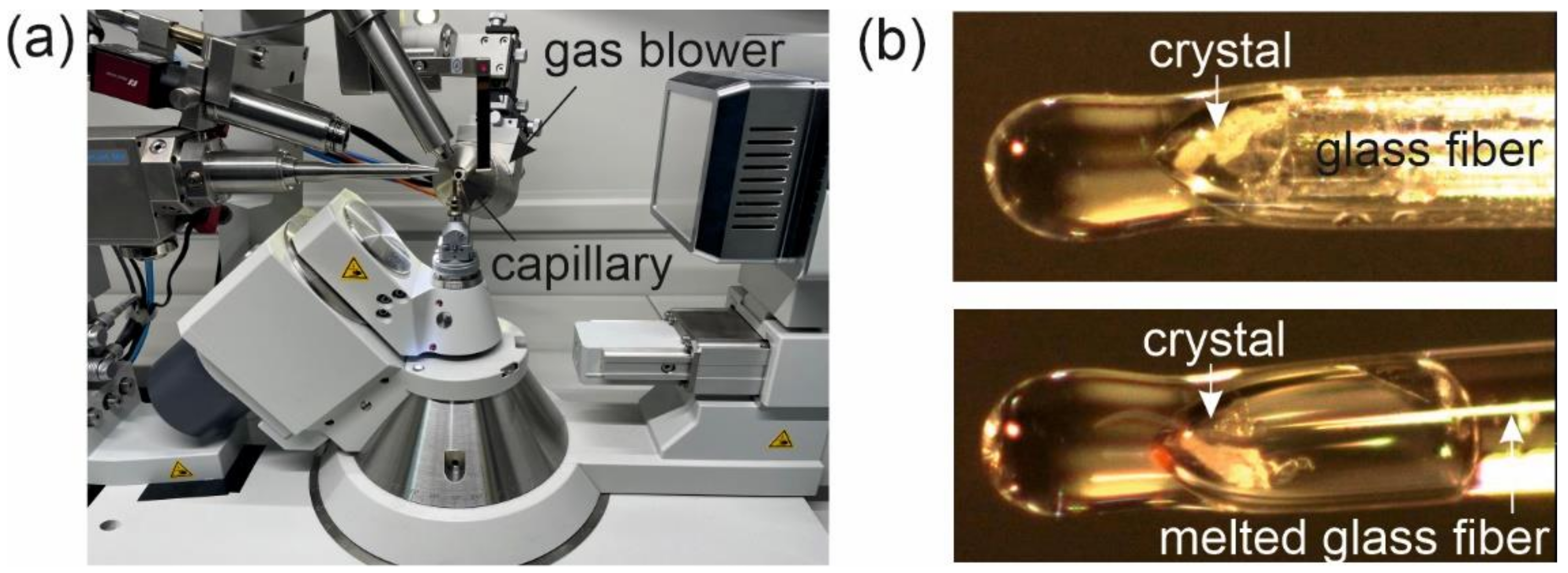
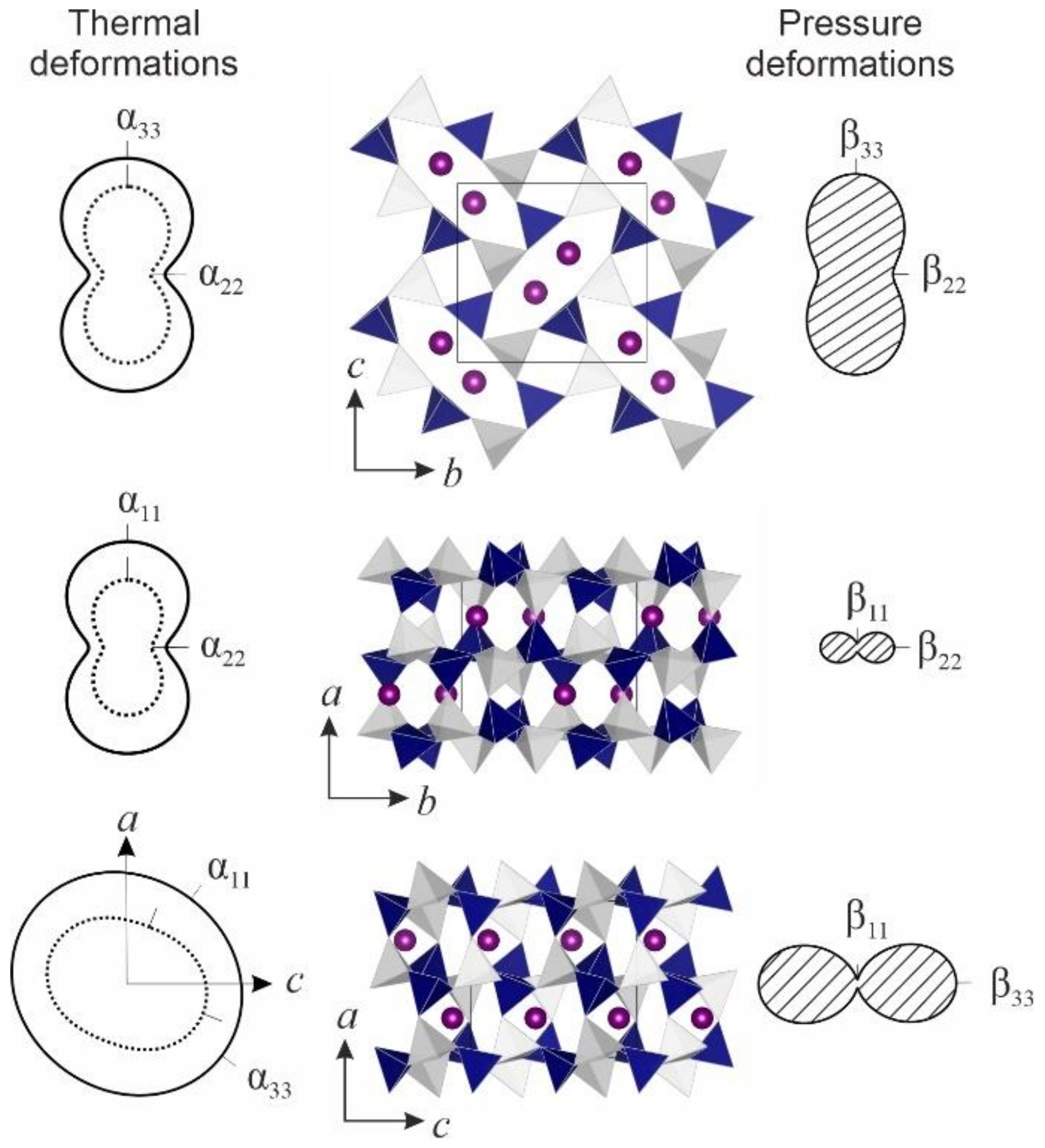
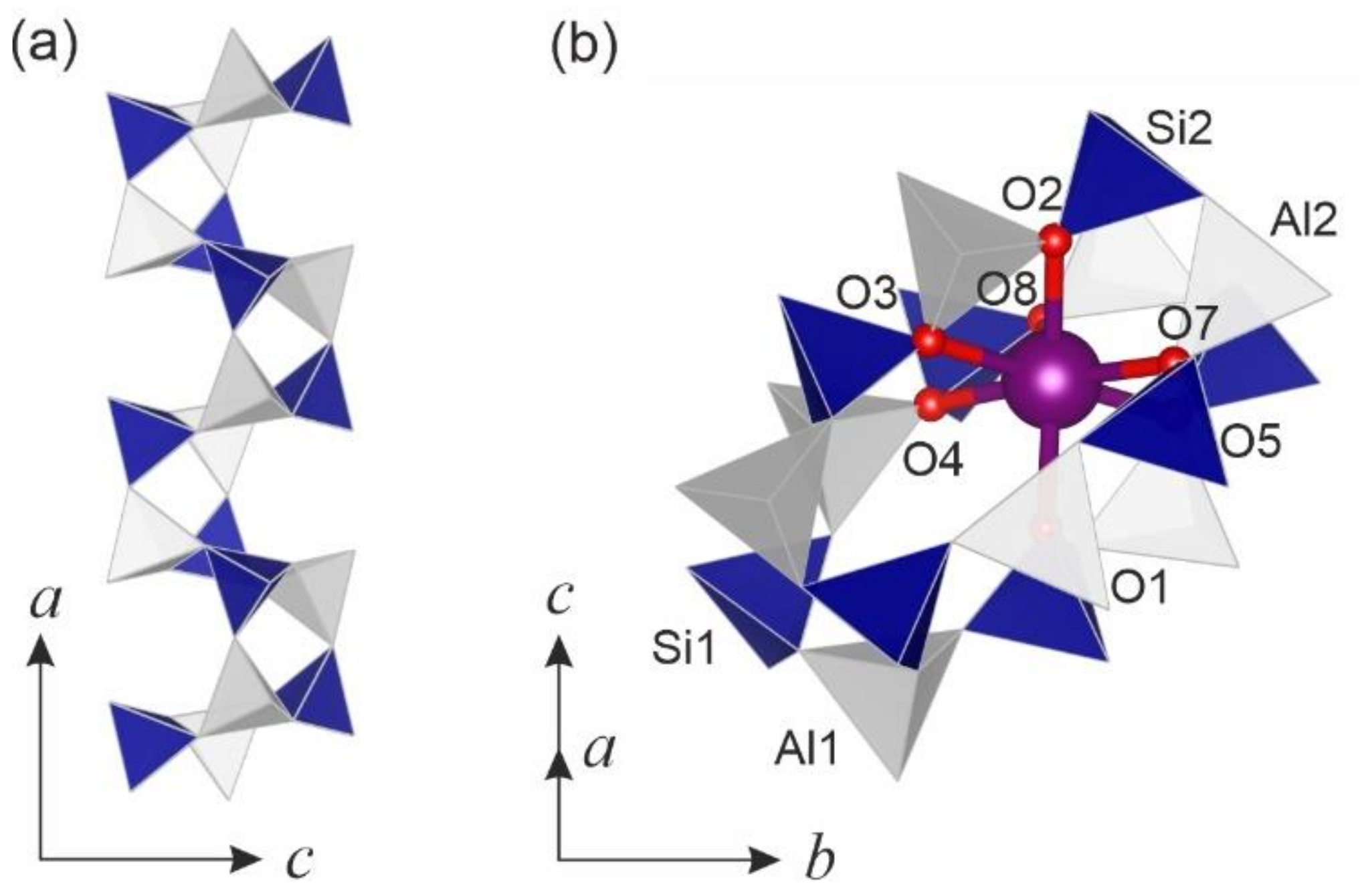
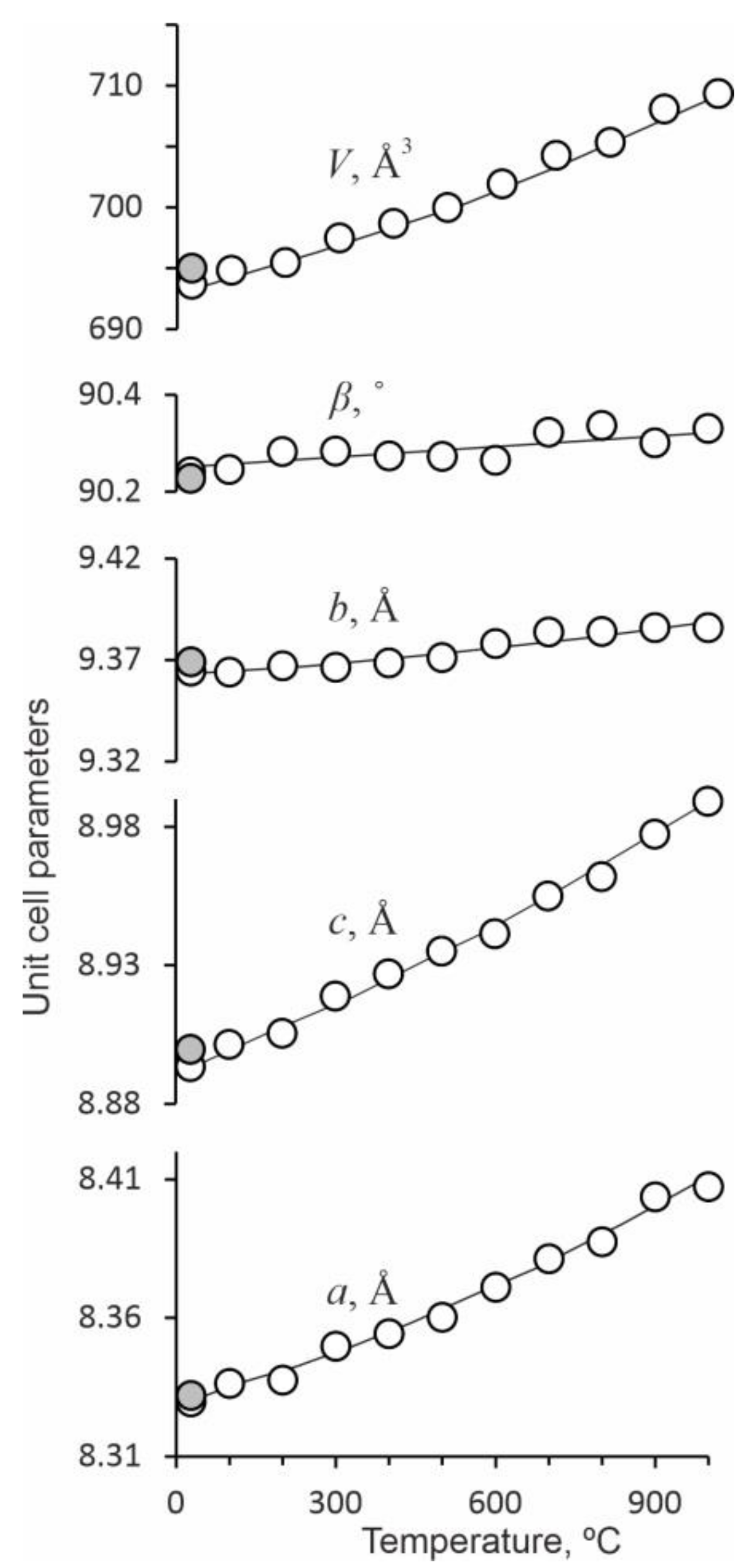
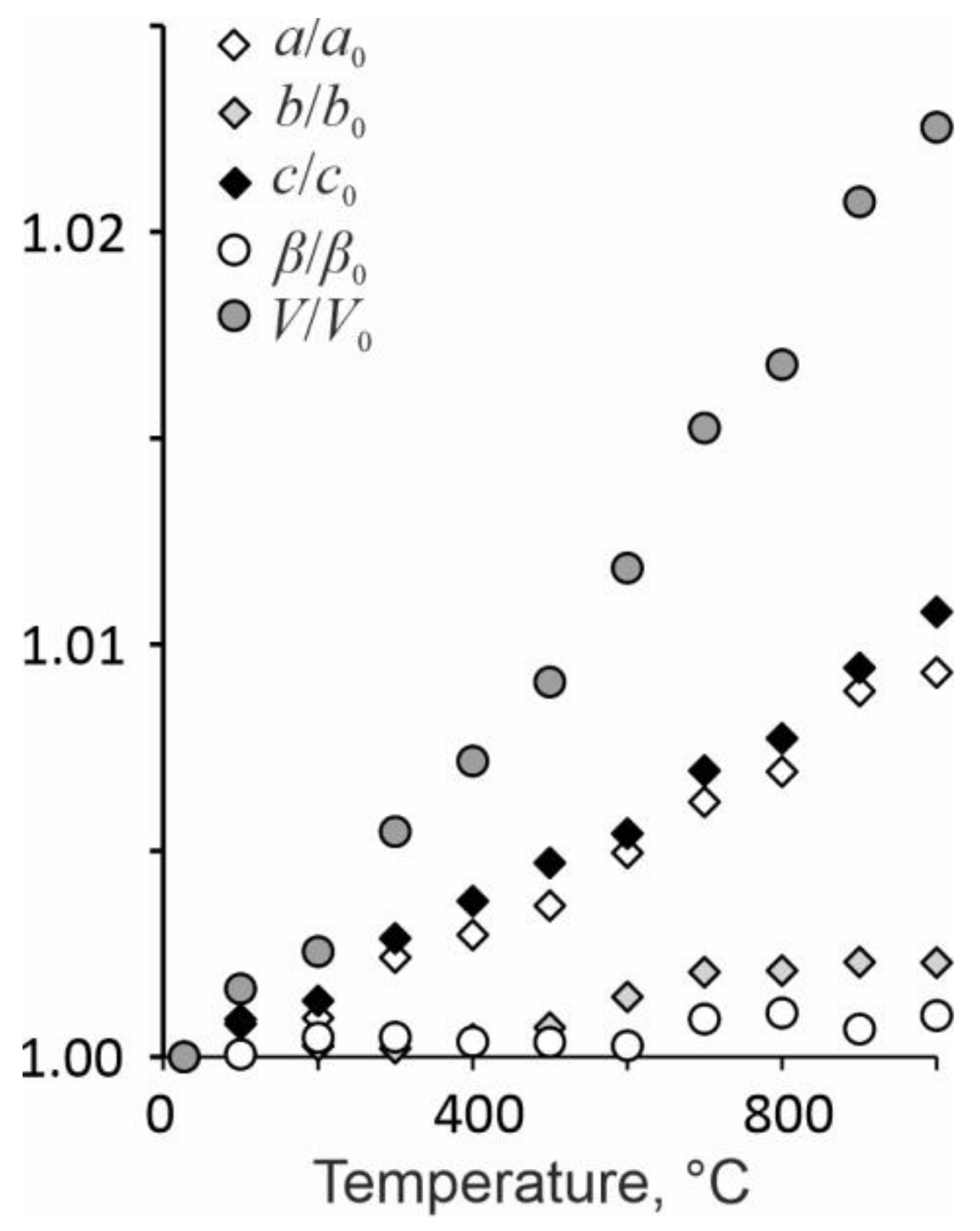
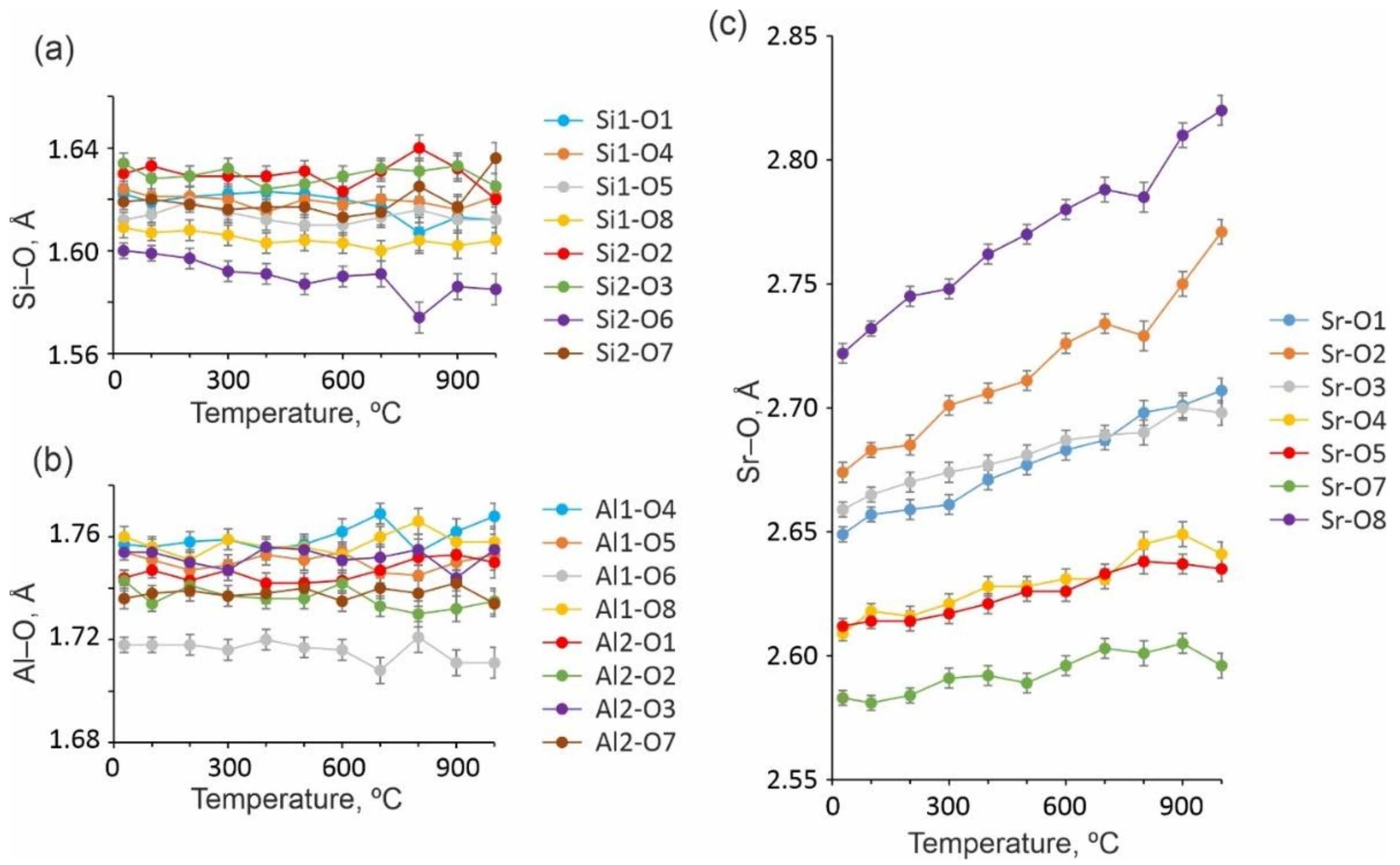
| Temperature, °C | 27 | 100 | 200 | 300 | 400 | 500 | 600 | 700 | 800 | 900 | 1000 | 27 |
|---|---|---|---|---|---|---|---|---|---|---|---|---|
| Temperature Point | T00 | T01 | T02 | T03 | T04 | T05 | T06 | T07 | T08 | T09 | T10 | T11 |
| Space group | P21/c | |||||||||||
| a, Å | 8.3298(6) | 8.3364(6) | 8.3376(6) | 8.3498(7) | 8.3544(7) | 8.3603(8) | 8.3710(9) | 8.381(1) | 8.387(1) | 8.404(1) | 8.407(1) | 8.3320(7) |
| b, Å | 9.3645(7) | 9.3641(7) | 9.3670(7) | 9.3664(7) | 9.3685(8) | 9.3711(9) | 9.3781(9) | 9.3837(7) | 9.384(1) | 9.3860(9) | 9.3859(9) | 9.3677(6) |
| c, Å | 8.8934(8) | 8.9014(7) | 8.9054(8) | 8.9189(8) | 8.9269(9) | 8.9352(9) | 8.942(1) | 8.9551(7) | 8.962(1) | 8.9773(9) | 8.989(1) | 8.8887(7) |
| β, ° | 90.242(8) | 90.246(8) | 90.283(9) | 90.285(9) | 90.27(1) | 90.27(1) | 90.26(1) | 90.323(9) | 90.34(1) | 90.30(1) | 90.33(1) | 90.229(7) |
| Volume, Å3 | 693.7(1) | 694.86(9) | 695.5(1) | 697.5(1) | 698.7(1) | 700.0(1) | 701.9(1) | 704.3(1) | 705.4(2) | 708.1(1) | 709.4(1) | 694.55(9) |
| Z | 4 | |||||||||||
| Data collection | ||||||||||||
| Wavelength, Å | 0.71073 | |||||||||||
| Max. θ° | 29.343 | 29.310 | 29.304 | 29.458 | 29.442 | 29.421 | 29.385 | 29.173 | 29.144 | 29.093 | 29.226 | 29.334 |
| Index ranges | −11 ≤ h≤ 11 −8 ≤ k ≤ 12 −11 ≤ l ≤ 9 | −11 ≤ h ≤ 11 −8 ≤ k ≤ 12 −11 ≤ l ≤ 9 | −11 ≤ h ≤ 11 −8 ≤ k ≤ 12 −11 ≤ l ≤ 9 | −11 ≤ h ≤ 11 −8 ≤ k ≤ 12 11 ≤ l ≤ 9 | −11 ≤ h ≤ 11 −8 ≤ k ≤ 12 −11 ≤ l ≤ 9 | −11 ≤ h ≤ 11 −8 ≤ k ≤ 12 −11 ≤ l ≤ 9 | −11 ≤ h ≤ 11 −8 ≤ k ≤ 12 −11 ≤ l ≤ 9 | −11 ≤ h ≤ 10 −7 ≤ k ≤ 12 −11 ≤ l ≤ 11 | −10 ≤ h ≤ 11 −7 ≤ k ≤ 12 −11 ≤ l ≤ 11 | −11 ≤ h ≤9 −7 ≤ k ≤ 12 −11 ≤ l ≤ 11 | −11 ≤ h ≤ 9 −7 ≤ k ≤ 12 −12 ≤ l ≤ 11 | −11 ≤ h ≤ 9 −8 ≤ k ≤ 12 −12 ≤ l ≤ 11 |
| No.meas.refl. | 4772 | 4736 | 4806 | 4773 | 4789 | 4814 | 4830 | 4876 | 4796 | 4559 | 4263 | 4628 |
| No.uniq.refl. | 1529 | 1522 | 1542 | 1538 | 1539 | 1543 | 1554 | 1590 | 1576 | 1567 | 1578 | 1557 |
| No. obs.refl(I > 2σ(I)) | 1249 | 1207 | 1203 | 1164 | 1132 | 1138 | 1076 | 1081 | 958 | 979 | 831 | 1191 |
| Refinement of the structure | ||||||||||||
| No.of variables | 118 | |||||||||||
| Rint | 0.0364 | 0.0382 | 0.0413 | 0.0500 | 0.0443 | 0.0467 | 0.0486 | 0.0481 | 0.0656 | 0.0520 | 0.0670 | 0.0453 |
| R1, all data | 0.0528 | 0.0526 | 0.0577 | 0.0648 | 0.0641 | 0.0712 | 0.0776 | 0.0866 | 0.1032 | 0.1077 | 0.1255 | 0.0662 |
| R1, I > 2σ(I) | 0.0352 | 0.0343 | 0.0371 | 0.0390 | 0.0367 | 0.0408 | 0.0404 | 0.0448 | 0.0500 | 0.0507 | 0.0476 | 0.0400 |
| wR2, all data | 0.0774 | 0.0731 | 0.0808 | 0.0856 | 0.0808 | 0.0873 | 0.0929 | 0.0944 | 0.1261 | 0.1020 | 0.1117 | 0.0840 |
| wR2, I > 2σ(I) | 0.0716 | 0.0676 | 0.0733 | 0.0779 | 0.0732 | 0.0788 | 0.0813 | 0.0821 | 0.1069 | 0.0865 | 0.0890 | 0.0761 |
| GooF | 1.041 | 1.036 | 1.056 | 1.029 | 0.984 | 1.027 | 0.988 | 1.038 | 0.988 | 1.032 | 0.932 | 1.035 |
| Temperature, °C | 27 | 100 | 200 |
|---|---|---|---|
| Temperature Point | T00 | T01 | T02 |
| Space group | P–1 | ||
| a, Å | 8.3243(8) | 8.3289(8) | 8.3326(9) |
| b, Å | 8.8940(8) | 8.9033(8) | 8.9056(9) |
| c, Å | 9.3705(9) | 9.3706(9) | 9.3730(9) |
| α, ° | 90.172(8) | 90.155(8) | 90.129(8) |
| β, ° | 90.086(8) | 90.086(8) | 90.053(8) |
| γ, ° | 90.270(8) | 90.263(8) | 90.306(8) |
| Volume, Å3 | 693.75(11) | 694.86(11) | 695.53(12) |
| Z | 4 | ||
| Data collection | |||
| Wavelength, Å | 0.71073 | ||
| Max. θ° | 29.352 | 29.339 | 29.312 |
| Index ranges | −11 ≤ h ≤ 11 −9 ≤ k ≤ 11 −12 ≤ l ≤ 8 | −11 ≤ h ≤11 −9 ≤ k ≤11 −12 ≤ l ≤8 | −11 ≤ h ≤ 1 1−9 ≤ k ≤ 11 −12 ≤ l ≤ 8 |
| No.meas.refl. | 4976 | 4918 | 4982 |
| No.uniq.refl. | 2693 | 2679 | 2705 |
| No. obs.refl(I > 2σ(I)) | 2045 | 2005 | 1985 |
| Refinement of the structure | |||
| No.of variables | 235 | 235 | 230 |
| Rint | 0.0372 | 0.0430 | 0.0424 |
| R1, all data | 0.0671 | 0.0716 | 0.0777 |
| R1, I > 2σ(I) | 0.0375 | 0.0401 | 0.0430 |
| wR2, all data | 0.0848 | 0.0913 | 0.0999 |
| wR2, I > 2σ(I) | 0.0772 | 0.0826 | 0.0884 |
| GooF | 1.003 | 1.024 | 1.025 |
| Temperature, °C | 27 | 100 | 200 | 300 | 400 | 500 | 600 | 700 | 800 | 900 | 1000 | 27 |
|---|---|---|---|---|---|---|---|---|---|---|---|---|
| Temperature Point | T00 | T01 | T02 | T03 | T04 | T05 | T06 | T07 | T08 | T09 | T10 | T11 |
| SiO4 tetrahedra | ||||||||||||
| Si1–O1 | 1.622(3) | 1.619(3) | 1.621(4) | 1.622(4) | 1.623(4) | 1.622(4) | 1.620(4) | 1.617(5) | 1.607(7) | 1.613(6) | 1.612(6) | 1.615(4) |
| Si1–O4 | 1.624(3) | 1.621(3) | 1.621(4) | 1.620(4) | 1.615(4) | 1.620(4) | 1.618(4) | 1.620(5) | 1.619(6) | 1.616(5) | 1.621(6) | 1.626(4) |
| Si1–O5 | 1.612(3) | 1.614(3) | 1.619(3) | 1.615(4) | 1.612(4) | 1.610(4) | 1.610(4) | 1.613(4) | 1.616(5) | 1.612(4) | 1.612(5) | 1.615(4) |
| Si1–O8 | 1.609(4) | 1.607(3) | 1.608(4) | 1.606(4) | 1.603(4) | 1.604(4) | 1.603(4) | 1.600(4) | 1.604(5) | 1.602(5) | 1.604(5) | 1.613(4) |
| <Si1–O> | 1.617 | 1.615 | 1.617 | 1.616 | 1.613 | 1.614 | 1.613 | 1.613 | 1.611 | 1.611 | 1.612 | 1.617 |
| Volume | 2.159 | 2.152 | 2.161 | 2.155 | 2.145 | 2.147 | 2.144 | 2.142 | 2.136 | 2.134 | 2.140 | 2.160 |
| Si2–O2 | 1.630(4) | 1.633(3) | 1.629(4) | 1.629(4) | 1.629(4) | 1.631(4) | 1.623(4) | 1.631(4) | 1.640(5) | 1.632(5) | 1.620(5) | 1.634(4) |
| Si2–O3 | 1.634(4) | 1.628(4) | 1.629(4) | 1.632(4) | 1.624(4) | 1.626(4) | 1.629(4) | 1.632(4) | 1.631(5) | 1.633(5) | 1.625(5) | 1.634(4) |
| Si2–O6 | 1.600(3) | 1.599(3) | 1.597(4) | 1.592(4) | 1.591(4) | 1.587(4) | 1.590(4) | 1.591(5) | 1.574(6) | 1.586(5) | 1.585(6) | 1.599(4) |
| Si2–O7 | 1.619(3) | 1.620(3) | 1.618(3) | 1.616(4) | 1.617(4) | 1.617(4) | 1.613(4) | 1.615(5) | 1.625(6) | 1.617(5) | 1.636(6) | 1.625(4) |
| <Si2–O> | 1.621 | 1.620 | 1.618 | 1.618 | 1.615 | 1.615 | 1.614 | 1.617 | 1.617 | 1.617 | 1.616 | 1.623 |
| Volume | 2.182 | 2.180 | 2.172 | 2.169 | 2.160 | 2.160 | 2.155 | 2.168 | 2.168 | 2.166 | 2.165 | 2.191 |
| AlO4 tetrahedra | ||||||||||||
| Al1–O4 | 1.757(4) | 1.756(4) | 1.758(4) | 1.759(4) | 1.755(4) | 1.757(4) | 1.762(5) | 1.769(4) | 1.754(5) | 1.762(5) | 1.768(5) | 1.755(4) |
| Al1–O5 | 1.754(3) | 1.751(3) | 1.747(4) | 1.749(4) | 1.753(4) | 1.751(4) | 1.754(4) | 1.746(5) | 1.745(6) | 1.750(5) | 1.753(6) | 1.750(4) |
| Al1–O6 | 1.718(3) | 1.718(3) | 1.718(4) | 1.716(4) | 1.720(4) | 1.717(4) | 1.716(4) | 1.708(5) | 1.721(6) | 1.711(5) | 1.711(6) | 1.715(4) |
| Al1–O8 | 1.760(4) | 1.756(3) | 1.751(4) | 1.759(4) | 1.756(4) | 1.756(4) | 1.753(4) | 1.760(4) | 1.766(5) | 1.758(5) | 1.758(6) | 1.756(4) |
| <Al1–O> | 1.747 | 1.745 | 1.744 | 1.746 | 1.746 | 1.745 | 1.746 | 1.746 | 1.746 | 1.745 | 1.747 | 1.744 |
| Volume | 2.729 | 2.720 | 2.711 | 2.721 | 2.722 | 2.718 | 2.724 | 2.722 | 2.723 | 2.719 | 2.729 | 2.712 |
| Al2–O1 | 1.744(3) | 1.747(3) | 1.743(4) | 1.747(4) | 1.742(4) | 1.742(4) | 1.743(4) | 1.747(5) | 1.752(7) | 1.753(6) | 1.750(6) | 1.753(4) |
| Al2–O2 | 1.743(4) | 1.734(3) | 1.741(4) | 1.737(4) | 1.736(4) | 1.736(4) | 1.742(4) | 1.733(4) | 1.730(5) | 1.732(5) | 1.735(5) | 1.736(4) |
| Al2–O3 | 1.754(3) | 1.754(3) | 1.750(4) | 1.747(4) | 1.756(4) | 1.755(4) | 1.751(5) | 1.752(5) | 1.755(6) | 1.744(5) | 1.755(6) | 1.753(4) |
| Al2–O7 | 1.736(4) | 1.738(3) | 1.739(4) | 1.737(4) | 1.738(4) | 1.740(4) | 1.735(4) | 1.740(4) | 1.738(5) | 1.742(5) | 1.734(5) | 1.744(4) |
| <Al2–O> | 1.744 | 1.743 | 1.743 | 1.742 | 1.743 | 1.743 | 1.743 | 1.743 | 1.744 | 1.743 | 1.743 | 1.747 |
| Volume | 2.691 | 2.686 | 2.685 | 2.678 | 2.684 | 2.684 | 2.683 | 2.682 | 2.686 | 2.680 | 2.686 | 2.703 |
| SrO7 polyhedra | ||||||||||||
| Sr–O1 | 2.649(3) | 2.657(3) | 2.659(4) | 2.661(4) | 2.671(4) | 2.677(4) | 2.683(4) | 2.687(4) | 2.698(5) | 2.701(5) | 2.707(5) | 2.653(4) |
| Sr–O2 | 2.674(4) | 2.683(3) | 2.685(4) | 2.701(4) | 2.706(4) | 2.711(4) | 2.726(4) | 2.734(4) | 2.729(6) | 2.750(5) | 2.771(5) | 2.675(4) |
| Sr–O3 | 2.659(3) | 2.665(3) | 2.670(4) | 2.674(4) | 2.677(4) | 2.681(4) | 2.687(4) | 2.689(4) | 2.690(5) | 2.700(5) | 2.698(5) | 2.656(4) |
| Sr–O4 | 2.609(3) | 2.618(3) | 2.616(4) | 2.621(4) | 2.628(4) | 2.628(4) | 2.631(4) | 2.631(4) | 2.645(5) | 2.649(5) | 2.641(5) | 2.617(4) |
| Sr–O5 | 2.612(3) | 2.614(3) | 2.614(4) | 2.617(4) | 2.621(4) | 2.626(4) | 2.626(4) | 2.633(4) | 2.638(5) | 2.637(4) | 2.635(5) | 2.612(4) |
| Sr–O7 | 2.583(3) | 2.581(3) | 2.584(3) | 2.591(4) | 2.592(4) | 2.589(4) | 2.596(4) | 2.603(4) | 2.601(5) | 2.605(4) | 2.596(5) | 2.580(4) |
| Sr–O8 | 2.722(4) | 2.732(3) | 2.745(4) | 2.748(4) | 2.762(4) | 2.770(4) | 2.780(4) | 2.788(5) | 2.785(6) | 2.810(5) | 2.820(6) | 2.726(4) |
| <Sr–O> | 2.644 | 2.650 | 2.653 | 2.659 | 2.665 | 2.669 | 2.676 | 2.681 | 2.684 | 2.693 | 2.696 | 2.646 |
| Volume | 24.852 | 24.993 | 25.094 | 25.265 | 25.421 | 25.520 | 25.717 | 25.828 | 25.915 | 26.175 | 26.208 | 24.893 |
| Temperature, °C | 27 | 100 | 200 |
|---|---|---|---|
| Temperature Point | T00 | T01 | T02 |
| SiO4 tetrahedra | |||
| Si1–O2 | 1.620(5) | 1.621(5) | 1.621(5) |
| Si1–O4 | 1.615(4) | 1.618(4) | 1.618(5) |
| Si1–O5 | 1.610(5) | 1.605(5) | 1.606(5) |
| Si1–O13 | 1.620(4) | 1.619(5) | 1.614(5) |
| <Si1–O> | 1.616 | 1.616 | 1.615 |
| Volume | 2.156 | 2.155 | 2.152 |
| Si2–O3 | 1.621(4) | 1.618(5) | 1.624(5) |
| Si2–O8 | 1.628(4) | 1.620(5) | 1.621(5) |
| Si2–O10 | 1.610(4) | 1.610(4) | 1.621(5) |
| Si2–O12 | 1.610(4) | 1.612(5) | 1.612(5) |
| <Si2–O> | 1.617 | 1.615 | 1.619 |
| Volume | 2.160 | 2.151 | 2.169 |
| Si3–O6 | 1.624(4) | 1.624(5) | 1.622(5) |
| Si3–O7 | 1.634(4) | 1.637(5) | 1.629(5) |
| Si3–O9 | 1.631(4) | 1.623(5) | 1.630(5) |
| Si3–O14 | 1.599(4) | 1.600(5) | 1.597(5) |
| <Si3–O> | 1.622 | 1.621 | 1.620 |
| Volume | 2.188 | 2.182 | 2.180 |
| Si4–O1 | 1.612(4) | 1.612(5) | 1.614(5) |
| Si4–O11 | 1.631(4) | 1.630(5) | 1.628(5) |
| Si4–O15 | 1.628(4) | 1.635(5) | 1.632(5) |
| Si4–O16 | 1.599(4) | 1.597(5) | 1.597(5) |
| <Si4–O> | 1.618 | 1.618 | 1.618 |
| Volume | 2.170 | 2.173 | 2.170 |
| AlO4 tetrahedra | |||
| Al1–O4 | 1.752(4) | 1.748(5) | 1.745(5) |
| Al1–O5 | 1.752(5) | 1.758(5) | 1.752(5) |
| Al1–O8 | 1.762(5) | 1.762(5) | 1.760(5) |
| Al1–O16 | 1.718(4) | 1.716(5) | 1.714(5) |
| <Al1–O> | 1.746 | 1.746 | 1.742 |
| Volume | 2.723 | 2.723 | 2.707 |
| Al2–O2 | 1.760(5) | 1.757(5) | 1.754(5) |
| Al2–O10 | 1.755(4) | 1.752(5) | 1.745(5) |
| Al2–O12 | 1.766(4) | 1.758(5) | 1.756(5) |
| Al2–O14 | 1.714(4) | 1.716(5) | 1.717(5) |
| <Al2–O> | 1.749 | 1.746 | 1.743 |
| Volume | 2.736 | 2.722 | 2.707 |
| Al3–O1 | 1.746(5) | 1.744(5) | 1.744(5) |
| Al3–O9 | 1.750(4) | 1.754(5) | 1.749(5) |
| Al3–O13 | 1.745(4) | 1.745(5) | 1.744(5) |
| Al3–O15 | 1.741(5) | 1.734(5) | 1.740(5) |
| <Al3–O> | 1.746 | 1.744 | 1.744 |
| Volume | 2.696 | 2.690 | 2.691 |
| Al4–O3 | 1.740(4) | 1.744(5) | 1.744(5) |
| Al4–O6 | 1.728(4) | 1.735(5) | 1.733(5) |
| Al4–O7 | 1.746(4) | 1.736(5) | 1.739(5) |
| Al4–O11 | 1.756(4) | 1.753(5) | 1.752(5) |
| <Al4–O> | 1.743 | 1.742 | 1.742 |
| Volume | 2.684 | 2.679 | 2.679 |
| SrO7 polyhedra | |||
| Sr1–O2 | 2.608(4) | 2.612(4) | 2.618(4) |
| Sr1–O5 | 2.724(4) | 2.727(5) | 2.742(5) |
| Sr1–O6 | 2.584(4) | 2.580(4) | 2.583(4) |
| Sr1–O9 | 2.660(4) | 2.668(4) | 2.670(4) |
| Sr1–O10 | 2.612(4) | 2.616(4) | 2.609(4) |
| Sr1–O13 | 2.648(4) | 2.659(5) | 2.664(5) |
| Sr1–O15 | 2.673(4) | 2.682(4) | 2.678(5) |
| <Sr1–O> | 2.644 | 2.649 | 2.652 |
| Volume | 24.834 | 24.956 | 25.048 |
| Sr2–O1 | 2.587(4) | 2.586(4) | 2.588(4) |
| Sr2–O3 | 2.653(4) | 2.660(5) | 2.655(5) |
| Sr2–O4 | 2.613(4) | 2.612(4) | 2.620(4) |
| Sr2–O7 | 2.671(4) | 2.680(4) | 2.686(5) |
| Sr2–O8 | 2.608(4) | 2.621(4) | 2.621(4) |
| Sr2–O11 | 2.666(4) | 2.668(4) | 2.675(4) |
| Sr2–O12 | 2.719(4) | 2.731(5) | 2.742(5) |
| <Sr2–O> | 2.645 | 2.651 | 2.655 |
| Volume | 24.915 | 25.045 | 25.157 |
| T, °C | α11 | α22 | α33 | μ (α33^c) | αa | αb | αc | αβ | αV |
|---|---|---|---|---|---|---|---|---|---|
| Linear approximation | |||||||||
| 27–1000 | 9.4(4) | 2.9(3) | 11.2(3) | 28.0(2) | 9.8(4) | 2.9(3) | 10.7(3) | 0.9(2) | 23.4(6) |
| Quadratic polynomial approximation | |||||||||
| 27 | 6(1) | 2(1) | 8.4(9) | 22.0(9) | 7(1) | 2(1) | 8.2(9) | 0.9(8) | 17(1) |
| 300 | 8.1(6) | 2.5(5) | 9.9(4) | 25.1(4) | 8.4(6) | 2.5(5) | 9.6(4) | 0.9(4) | 20.6(9) |
| 700 | 10.5(5) | 3.1(5) | 12.2(4) | 31.3(4) | 11.0(5) | 3.1(5) | 11.7(4) | 0.9(4) | 25.9(8) |
| 1000 | 12(1) | 4(1) | 13.9(9) | 37.1(8) | 13(1) | 4(1) | 13.3(9) | 0.9(8) | 30(1) |
Publisher’s Note: MDPI stays neutral with regard to jurisdictional claims in published maps and institutional affiliations. |
© 2021 by the authors. Licensee MDPI, Basel, Switzerland. This article is an open access article distributed under the terms and conditions of the Creative Commons Attribution (CC BY) license (https://creativecommons.org/licenses/by/4.0/).
Share and Cite
Gorelova, L.; Vereshchagin, O.; Kasatkin, A. Thermal Expansion and Polymorphism of Slawsonite SrAl2Si2O8. Minerals 2021, 11, 1150. https://doi.org/10.3390/min11101150
Gorelova L, Vereshchagin O, Kasatkin A. Thermal Expansion and Polymorphism of Slawsonite SrAl2Si2O8. Minerals. 2021; 11(10):1150. https://doi.org/10.3390/min11101150
Chicago/Turabian StyleGorelova, Liudmila, Oleg Vereshchagin, and Anatoly Kasatkin. 2021. "Thermal Expansion and Polymorphism of Slawsonite SrAl2Si2O8" Minerals 11, no. 10: 1150. https://doi.org/10.3390/min11101150
APA StyleGorelova, L., Vereshchagin, O., & Kasatkin, A. (2021). Thermal Expansion and Polymorphism of Slawsonite SrAl2Si2O8. Minerals, 11(10), 1150. https://doi.org/10.3390/min11101150






